winding (provisional) cast on
You need: 2 circular needles & yarn
* for knitting in the round you need only 1 circular – scroll to bottom, please
Needle 1 = needle you will knit with
Needle 2 = holder for the live sts (for more snug loops, use a smaller needle size)
1. Tie a slip-knot and place on Needle 2
Hold both needles together, Needle 1 on top
2. Wind yarn around both needles (from below, up and over, around back)
3. Continue to wind
4. When you have the desired number of stitches, pinch the yarn
against the needles and turn them around to knit
4.1 …like this
5. Holding yarn in place, pull Needle 2 through to dangle freely
5.1 (Needle 2 pulled through)
6. Getting ready to knit
7. Place yarn over index finger (around/catching Needle 2 cable)
8. Knit (or… work in whatever pattern your directions say)
9. Continue to knit
10. Knit final stitch and leave slip-knot in place on Needle 2
(remove this knot before knitting the live stitches on this cable)
Completed first row
(at this point the Winding Cast On equals Judy’s Magic cast-on –
so if you are using that or a similar provisional cast on for an Åsa Tricosa
pattern, you should skip the first knitted row)
First row seen from WS (wrong side)
Three rows completed
In this example, the live stitches are left on Needle 2 to be worked later
The work grows upwards in one direction.
This can be useful for
- knitting each half of a scarf or shawl from the centre and outwards (as in Serangoon)
- knitting each half of collar from centre back (as in Tric and Koronki, or Abraxas)
- saving the hem decision on a bottom-up sweater for last
- identical cast offs and edges for a scarf
- knitting the first leaf of the Semele shawl
- starting the Galathea shawl
- starting shawl borders (as on Mayhem, Abraxas Crescent)
FOR TOE-UP SOCKS, TOP-DOWN MITTENS & TOP-DOWN HATS
The Winding Cast On is equally useful for starting a toe-up sock or top-down
mitten and top-down hats.
In that case you need only ONE circular and will knit the live stitches on Needle (Tip) 2 immediately after knitting
back the first row and in this way work in the round – that is, in „two directions“.
(Knit the stitches on Needle Tip 1, then flip the work over to knit the stitches on
Needle Tip 2 = 1 round)
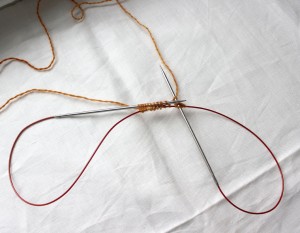
You can of course use two circulars instead of magic looping.
Or double pointed needles once you have completed the cast on and first round.
Want to know what’s up my knitted sleeve? Sign up for the occasional Åsa Tricosa Newsletter.
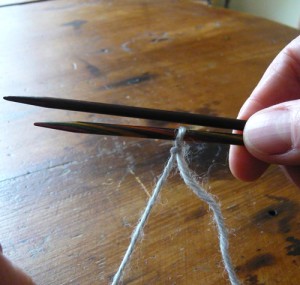
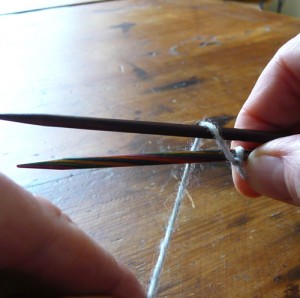
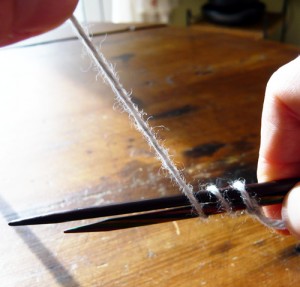
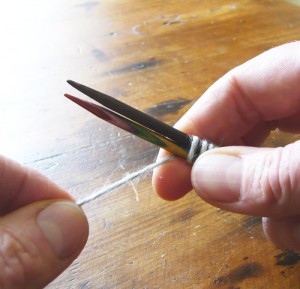
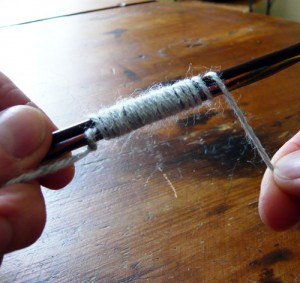
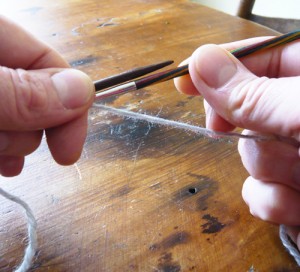
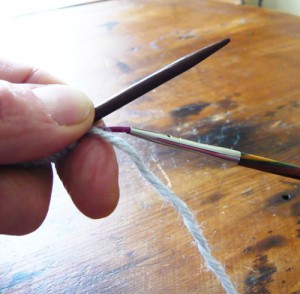
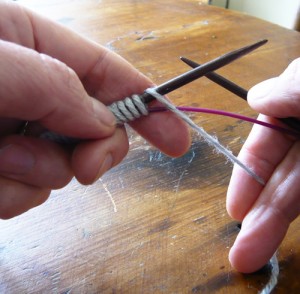
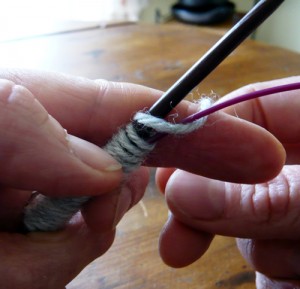
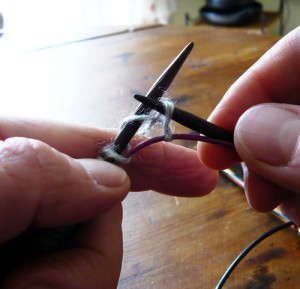
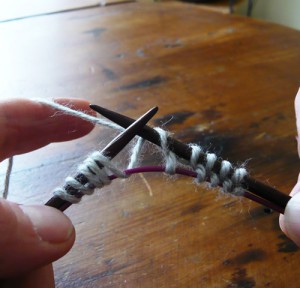
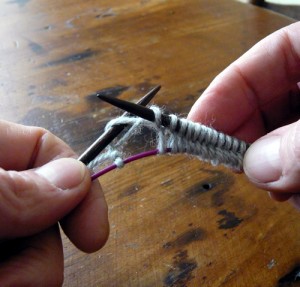
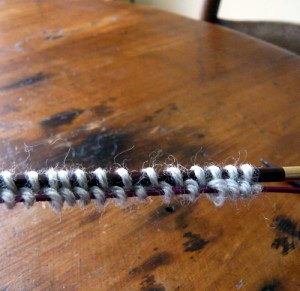
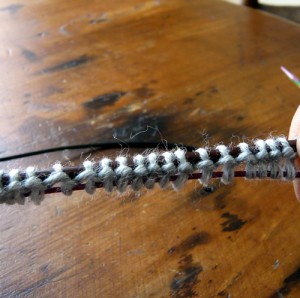
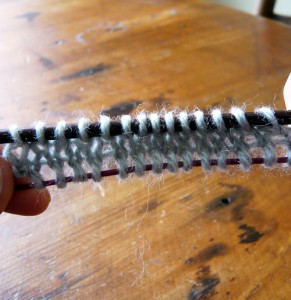

32 Comments
thanks for the provisional cast-on instruction!!
At last I understand it.
Great!
It’s really useful and so very simple, no?
[…] enjoyed Asa Tricosa’s video on winding provisional cast-on. It’s really handy, especially on a piece like this where […]
I am trying the winding provisional cast on. As I knit the last few stitches, the slack on the needle keeps getting bigger so that when the last stich is knitted there is extra yarn between the last stitch and the slip knot. I am not sure what I am doing wrong. How do you keep all the stitches taut on the needle?
Thank you
Hello there!
Don’t worry about the slack – it simply becomes part of the beginning yarn end when you get rid of the slipknot (the slipknot is pushed off the needle and undone before you start working the provisional stitches.)
Thanks so much for your reply. I just purchased the Tiong Bahru pattern and I am very excited about knitting it! Thank you !
Oh good! I’m looking forward to seeing how you progress!
what is LOOP at end of row 3 galathea? i have just dropped the provisional cast on slip knot but i i dont know what to do next or how o do it? :-/
x
Your method appears very straight forward and easy – I’m going to try it – Thank You.
Hello.
I am trying to knit the semele shawl and it does not seem to be coming up right. I finished the first leave and the chart b does not seen to work right. It seems that d second leave starts on the wrong side. Please help understand beginning of chart be
Well, I’m not sure what’s going wrong for you. Are you picking up the stitches on or along the wrong side, perhaps? If you look at the photo tutorial you should be able to see where and in what direction to pick up the stitches. I should perhaps add that this is my most knitted pattern so I trust that it works as intended. There is always the possibility of a typo or something gone wrong somewhere, but this one has really been tested and knitted many, many, many times. Good luck!
I use a provisional cast on similar to the one here. However, I found it a bit awkward and so I’ve changed from winding around the two needles, as shown, to doing a kind of figure 8 with the yarn around the two needles. This prevents the yarn from overlapping each other and allows a bit of space between the „wraps“, which makes it easier to knit the first row. Thanks for your tutorial. It was very helpful.
Yes, whatever works best use it!
What I like about the plain winding is its very plainness – so it’s suitable for even the most beginny of beginners. Come to think of it, the cast on (long tail, etc) is often the trickiest part of learning to knit.
(Oh, and THANK YOU!)
Os there any diference between magi cast on and winding cast on? I want to know if the result is the same?
Yes, the result is the same.
However, there is this difference: with many provisional cast on methods (including Judy’s Magic Cast On) the first knitted row is completed already with the cast on itself.
With Provisional Winding Cast on you can begin a lace or cable pattern immediately after winding instead of knitting back (Step 6) over the wound stitches and so avoid any extra“ plain row interrupting the pattern.
p.s. I should add a note under Photo 6 to say: for a lace or cable pattern, begin the pattern here.
Hello! Thank you for the tutorial on how to provisionally cast on to a cable.
I do have a question though. The project I am doing is a hat which has a liner inside. So, the directions say to provisionally cast on with the liner color, join in the round and knit 3 inches of liner color and bind off. Then, with the main color, begin knitting the provisionally cast on stitches (obviously in the round).
I cannot figure out how/when to join in the round after I have provisionally cast on my stitches to the extra cable.Can you help me through this? Ideally I would like to knit this hat using the magic loop method, but if that’s not possible, I can just use my shorter circular cables.
Not sure I know what to do. Is this a bottom-up hat, then?
If it helps, I usually knit back and forth one or two rows before joining in the round. The miniature gap the creates can be closed with the cast on yarn end later. It’s rather fiddly to close in the round with two needles and magic looping without first knitting two rows or so. I find…
And why not instead of binding off, knit the lining stitches together with the main colour instead of sewing it later… (that may just be my own obsession with doing everything in the process of knitting).
p.s. I knit this lined hem, but that is for a top down hat.
Thank you so much for your very clear tutorial.
I am particularly grateful for your mentioning that it is possible to work the first row in stitches other than ‚knit‘ only (8.), as I have a pattern which calls for moss stitch for a hood which I want to avoid having to seam or graft.
Also, for reminding us to leave the slip knot on Needle 2 until those stitches are worked, when the cast-on is provisional.
Your comments and photos were very helpful.
Thank you! I’m really pleased to know that it helped.
Thank you for such a nice tutorial for perfect cast on! I love it very much!
I’ll use it in my pattern. Of course I’ll name you and link it properly.
Hello Äsa,
this is the turkish cast on method 😊
Yes, that’s indeed one of its names!
🙂
I am glad I found this tutorial for Winding/Turkish Cast-On telling me how to do it for knitting in the flat instead of in the round. This has saved me! Thank you!
Are there some pics from the cast on from de Bento boksy? I don’t understand the explanation from row 1 – 3….. How can you get the stitches on 1 cable?
What, more preciesly, about it don’t you understand? (For speedier – and usually better! – help, please post in the Bento Boksy thread on Ravelry. You’ll find friendly and helpful knitters there! (in the meantime I’ll look to see whether there are any pics somewhere.)
What is the down side to using a regular cast on and starting with row 1 for the semele shawl?
With a regular cast on, you get an intervening plain knitted row. And you would als need to pick up stitches in the cast on to knit in the opposite direction later, which creates a little ’seam‘ or ridge. That’s not a disaster, if you don’t mind how it looks!
Hello dear Asa,
i love your method of knitting! My question is when will your book Ziggurat al German translation be in stores?
Kind regards from Pfungstadt near Darmstadt in Hessen
I knitted two sweaters with the ziggurat method. These fit perfectly!
I’m so pleased your Ziggurats fit!
Translation: it’s still not clear whether the entire book will become available in German or just translations pattern by pattern.
Thanks for asking! Thanks for writing! Knit with abandon! /Åsa
Hi Asa,
I am so glad i found this provisional cast on.I have tried several and this one is the best.I just bought your book and can’t wait to get knitting.
Glad you find it useful! Thank you for buying my book – I hope you’ll create some nice, favourite sweaters inspired by it.